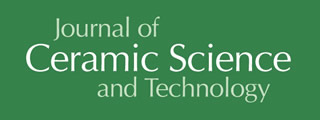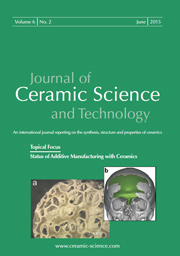Articles
All articles | Recent articles
Porous TiO2-Y2O3 Ceramics with Specific Infrared-Optical Properties
G. Steinborn1, G. Tzschichholz1, J. Guenster1, M.H. Keller2, J. Manara2
1 BAM Federal Institute for Materials Research and Testing, Unter den Eichen 87, 12200 Berlin (Germany);
2 Bavarian Center for Applied Energy Research (ZAE Bayern), Am Hubland, 97074 Wuerzburg (Germany)
received March 20, 2011, recieved in revised form April 28, 2011, accepted May 31, 2011
Vol. 2, No. 3, Pages 183-190 DOI: 10.4416/JCST2011-00011
Abstract
The infrared-optical properties and particularly the emissivity of sintered ceramics depend on the material's bulk properties and structural properties such as porosity, pore size distribution and pore diameter. The infrared-optical properties can be varied across a wide range by specifically selecting the material's bulk and structural properties. A major concern of the present study is the development of a ceramic coating material with a total emissivity below 0.2 at a temperature of 800 °C. For this purpose, various samples of a TiO2-Y2O3 (TY) ceramic composite were produced with different properties. On variation in the Y2O3 content from 5 to 60 wt%, the porosity of the ceramic composites varies from 3 % to 47 % with the mean pore diameter lying in a range from 0.3 μm to 1.7 μm. The addition of graphitic pore builders increases the porosity up to 60 % and the mean pore diameter to a maximum of 15 μm. By optimizing the total porosity and the pore size of the TY ceramics, a total emissivity as low as 0.17 at 800 °C could be achieved.
![]() Download Full Article (PDF)
Download Full Article (PDF)
Keywords
Oxide ceramic, porosity, mean pore diameter, infrared optical properties, emissivity
References
1 Palik, E.D.: Handbook of optical constants of solids. Academic Press, San Diego, (1998).
2 Garcia, G., Figueras, A., Merino, R.I., Orera, V.M., Llibre, J.: Structural and Optical Properties of Yttria-Stabilized-Zirconia Films Grown by MOCVD, Thin Solid Films, 370, 173 – 178, (2000).
3 Manara, J., Reidinger, M., Korder, S., Arduini-Schuster, M., Fricke, J: Development and Characterization of Low-Emitting Ceramics, Int. J. Thermophys., 28, 1628 – 1645, (2007).
4 Manara, J: Infrared-optical radiative transfer for analysis of the structure and thermal conductivity of ceramics for high-temperature applications (in German), PhD dissertation at the Bavarian Julius-Maximilian-University of Wuerzburg, (2001).
5 Keller, M.H., Manara, J, Tzschichholz, G., Steinborn, G: Porous Ceramics with Optimized Infrared-Optical Properties, Proceedings 5th European Thermal-Sciences Conference, Editors: G.G.M. Stoffels, T.H. van der Meer and A.A. van Steenhoven, ISBN 978 – 90 – 386 – 1274 – 4, Eindhoven, (2008).
6 Manara, J., Caps, R., Raether, F., Fricke, J.: Characterization of the Pore Structure of Alumina Ceramics by Diffuse Radiation Propagation in the Near Infrared, Opt. Commun., 168, 237 – 250, (1999).
7 Manara, J., Caps, R., Fricke, J.: Characterisation of the Pore Structure of Ceramics via Propagation of Light and Infrared Radiation, Int. J. Thermophys., 26, 531 – 542, (2005).
8 Rozenbaum, O., De Sousa Meneses, D., Echegut, P.: Texture and Porosity Effects on the Thermal Radiative Behavior of Alumina Ceramics, Int. J. Thermophys., 30, 580 – 590, (2009).
9 Fricke, J., Caps, R., Hümmer, E., Döll, G., Arduini, M.C., DePonte, F.: Optically Thin
10 Fibrous Insulations. Insulations Materials: Testing and Application, ASTM STP 1030, 575 – 586, (1990).
11 Wagner, W.: Heat Transfer: Fundamentals (in German), Vogel Verlag, Würzburg, (1993).
12 Mie, G.: Studies of the Optics of Turbid Media, Particularly Colloidal Metal Solutions (in German), Ann. Physik, 25, 377 – 445, (1908).
13 Mattern, A.: Interpenetrating Metal-Ceramic Composites with Isotropic and Anisotropic Al2O3 Reinforcement (in German). Department of Mechanical Engineering, University of Karlsruhe (TH), Dissertation, (2005).
14 Kittel, C.: Introduction to Solid-State Physics (in German), 14th Edition, Oldenbourg Wissenschaftsverlag GmbH, Munich, (2005).
15 Bohren, C.F., Huffmann, D.R.: Absorption and Scattering of Light by Small Particles, New York: John Wiley & Sons, (1983).
16 Siegel, R., Howell, J.R.: Thermal Radiation – Heat Transfer. Washington: McGraw-Hill, (1981).
17 DIN 66137 – 2:2004. Determination of Solid State Density – Part 2: Gas Pycnometry.
18 DIN EN 993 – 1:1995. Methods of Test for Dense Shaped Refractory Products – Part 1: Determination of Bulk Density, Apparent Porosity and True Porosity.
19 Giesche, H.: Mercury Porosimetry – a General Practical Overview, Part. Part. Syst. Charact., 23, 9 – 19, (2006).
20 Hoffmann, D., Rübner, K.: Characterization of Mineral Building Materials by Mercury Porosimetry, Part. Part. Syst. Charact., 23, 20 – 28, (2006).
21 Carruthers, J.D.: The Physical Significance of Mercury Porosity Hysteresis in the Characterization of Calcined Precipitated Alumina, Part. Part. Syst. Charact., 23, 61 – 71, (2006).
22 ISO 15901 – 1:2005. Pore Size Distribution and Porosity of Solid Materials by Mercury Porosimetry and Gas Adsorption – Part 1: Mercury Porosimetry.
23 Jackson, J.D., An, P., Fabregat, S.D.: Measurement of the Total and Spectral Emittance of a Microporous Ceramic Material, High Temperatures – High Pressures, 30, [59], 523 – 529, (1998).
24 Knote, A., Krüger, H.G., Kern, H., Manara, J.: Electrophoretic Coating for the Realization of Low-Emitting Ceramic Layers (in German), Thüringer Werkstofftag 2004, Schriftenreihe Werkstoffwissenschaften Band 18, Verlag Dr. Köster, Berlin, 97 – 102, (2004).
Copyright
Göller Verlag GmbH


